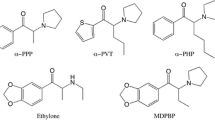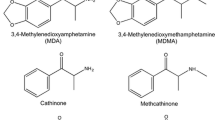Abstract
Rationale
Synthetic cathinones are chemical derivatives of cathinone that are pharmacologically similar to cocaine and methamphetamine. Recently, abuse of synthetic cathinones among young people has increased.
Objectives
The present study aimed to characterize the behavioral effects of alpha-pyrrolidinopentiothiophenone (PVT), an analog of alpha-pyrrolidinovalerophenone and second-generation synthetic cathinone, as well as to evaluate its abuse potential, using conditioned place preference, intravenous self-administration (SA), and drug discrimination paradigms in rodent models.
Results
Alpha-PVT produced a significant place preference in mice at doses of 10, 30, and 50 mg/kg. In the SA experiment, alpha-PVT (0.1, 0.3, and 1.0 mg/kg/infusion) produced an inverted U-shaped dose-effect curve in rats. Under a progressive ratio schedule of reinforcement, there appeared to be a positive relationship between alpha-PVT dose and the breakpoints for alpha-PVT reinforcement. Additionally, alpha-PVT fully substituted for the discriminative stimulus effects of both cocaine and methamphetamine in rats.
Conclusions
Our results indicate that alpha-PVT has rewarding and reinforcing effects and shares the interoceptive effects of cocaine and methamphetamine. To the best of our knowledge, the present study is the first to show that alpha-PVT has reinforcing properties when delivered on its own, which suggests possible abuse liability in humans.






Similar content being viewed by others
References
Aarde SM, Creehan KM, Vandewater SA, Dickerson TJ, Taffe MA (2015) In vivo potency and efficacy of the novel cathinone alpha-pyrrolidinopentiophenone and 3,4-methylenedioxypyrovalerone: self-administration and locomotor stimulation in male rats. Psychopharmacology 232:3045–3055
Ator NA, Griffiths RR (2003) Principles of drug abuse liability assessment in laboratory animals. Drug Alcohol Depend 70:S55–S72
Bonano JS, Glennon RA, De Felice LJ, Banks ML, Negus SS (2014) Abuse-related and abuse-limiting effects of methcathinone and the synthetic “bath salts” cathinone analogs methylenedioxypyrovalerone (MDPV), methylone and mephedrone on intracranial self-stimulation in rats. Psychopharmacology 231:199–207
Di Chiara G, Bassareo V (2007) Reward system and addiction: what dopamine does and doesn’t do. Curr Opin Pharmacol 7:69–76
Gatch MB, Taylor CM, Forster MJ (2013) Locomotor stimulant and discriminative stimulus effects of ‘bath salt’ cathinones. Behav Pharmacol 24:437–447
Gatch MB, Dolan SB, Forster MJ (2015) Comparative behavioral pharmacology of three pyrrolidine-containing synthetic cathinone derivatives. J Pharmacol Exp Ther 354:103–110
Glennon RA, Young R (2016) Neurobiology of 3,4-methylenedioxypyrovalerone (MDPV) and alpha-pyrrolidinovalerophenone (alpha-PVP). Brain Res Bull 126:111–126
Hiranita T, Kohut SJ, Soto PL, Tanda G, Kopajtic TA, Katz JL (2014) Preclinical efficacy of N-substituted benztropine analogs as antagonists of methamphetamine self-administration in rats. J Pharmacol Exp Ther 348:174–191
Kaizaki A, Tanaka S, Numazawa S (2014) New recreational drug 1-phenyl-2-(1-pyrrolidinyl)-1-pentanone (alpha-PVP) activates central nervous system via dopaminergic neuron. J Toxicol Sci 39:1–6
King HE, Wetzell B, Rice KC, Riley AL (2015) An assessment of MDPV-induced place preference in adult Sprague-Dawley rats. Drug Alcohol Depend 146:116–119
Marusich JA, Antonazzo KR, Wiley JL, Blough BE, Partilla JS, Baumann MH (2014) Pharmacology of novel synthetic stimulants structurally related to the “bath salts” constituent 3,4-methylenedioxypyrovalerone (MDPV). Neuropharmacology 87:206–213
Mello NK, Negus SS (1996) Preclinical evaluation of pharmacotherapies for treatment of cocaine and opioid abuse using drug self-administration procedures. Neuropsychopharmacology : official publication of the American College of Neuropsychopharmacology 14:375–424
Meltzer PC, Butler D, Deschamps JR, Madras BK (2006) 1-(4-Methylphenyl)-2-pyrrolidin-1-yl-pentan-1-one (pyrovalerone) analogues: a promising class of monoamine uptake inhibitors. J Med Chem 49:1420–1432
Olmstead MC (2011) Animal models of drug addiction. Humana Press, New York
Pickens R, Thompson T (1968) Cocaine-reinforced behavior in rats: effects of reinforcement magnitude and fixed-ratio size. J Pharmacol Exp Ther 161:122–129
Pierce RC, Kumaresan V (2006) The mesolimbic dopamine system: the final common pathway for the reinforcing effect of drugs of abuse? Neurosci Biobehav Rev 30:215–238
Richardson NR, Roberts DC (1996) Progressive ratio schedules in drug self-administration studies in rats: a method to evaluate reinforcing efficacy. J Neurosci Methods 66:1–11
Roberts DC, Loh EA, Vickers G (1989) Self-administration of cocaine on a progressive ratio schedule in rats: dose-response relationship and effect of haloperidol pretreatment. Psychopharmacology 97:535–538
Smith JE, Co C, Coller MD, Hemby SE, Martin TJ (2006) Self-administered heroin and cocaine combinations in the rat: additive reinforcing effects-supra-additive effects on nucleus accumbens extracellular dopamine. Neuropsychopharmacology : official publication of the American College of Neuropsychopharmacology 31:139–150
Spiller HA, Ryan ML, Weston RG, Jansen J (2011) Clinical experience with and analytical confirmation of “bath salts” and “legal highs” (synthetic cathinones) in the United States. Clin Toxicol 49:499–505
Swortwood MJ, Carlier J, Ellefsen KN, Wohlfarth A, Diao X, Concheiro-Guisan M, Kronstrand R, Huestis MA (2016) In vitro, in vivo and in silico metabolic profiling of alpha-pyrrolidinopentiothiophenone, a novel thiophene stimulant. Bioanalysis 8:65–82
Tzschentke TM (2007) Measuring reward with the conditioned place preference (CPP) paradigm: update of the last decade. Addict Biol 12:227–462
Uchiyama N, Matsuda S, Kawamura M, Kikura-Hanajiri R, Goda Y (2013) Two new-type cannabimimetic quinolinyl carboxylates, QUPIC and QUCHIC, two new cannabimimetic carboxamide derivatives, ADB-FUBINACA and ADBICA, and five synthetic cannabinoids detected with a thiophene derivative alpha-PVT and an opioid receptor agonist AH-7921 identified in illegal products. Forensic Toxicol 31:223–240
Watterson LR, Olive MF (2014) Synthetic cathinones and their rewarding and reinforcing effects in rodents. Adv Neurosci (Hindawi) 2014:209875
Watterson LR, Kufahl PR, Nemirovsky NE, Sewalia K, Grabenauer M, Thomas BF, Marusich JA, Wegner S, Olive MF (2014) Potent rewarding and reinforcing effects of the synthetic cathinone 3,4-methylenedioxypyrovalerone (MDPV). Addict Biol 19:165–174
Yoon SS, Kim H, Choi KH, Lee BH, Lee YK, Lim SC, Choi SH, Hwang M, Kim KJ, Yang CH (2010) Acupuncture suppresses morphine self-administration through the GABA receptors. Brain Res Bull 81:625–630
Zakharova E, Leoni G, Kichko I, Izenwasser S (2009) Differential effects of methamphetamine and cocaine on conditioned place preference and locomotor activity in adult and adolescent male rats. Behav Brain Res 198:45–50
Zimmer BA, Dobrin CV, Roberts DC (2013) Examination of behavioral strategies regulating cocaine intake in rats. Psychopharmacology 225:935–944
Acknowledgements
This work was supported by a grant (14182MFDS979) from Ministry of Food and Drug Safety in 2016 and Korea Institute of Toxicology (KK-1610-03).
Author information
Authors and Affiliations
Corresponding author
Ethics declarations
The experimental procedures were approved by the Institutional Animal Care and Use Committee of the Korea Institute of Toxicology and met the requirements of the National Institutes of Health Guide for the Care and Use of Laboratory Animals (NIH No. 85–23, rev. 1985).
Conflict of interest
The authors declare that they have no conflict of interest.
Additional information
Jae Hoon Cheong and Mee Jung Choi have contributed equally to this work.
Rights and permissions
About this article
Cite this article
Cheong, J.H., Choi, M.J., Jang, CG. et al. Behavioral evidence for the abuse potential of the novel synthetic cathinone alpha-pyrrolidinopentiothiophenone (PVT) in rodents. Psychopharmacology 234, 857–867 (2017). https://doi.org/10.1007/s00213-017-4526-8
Received:
Accepted:
Published:
Issue Date:
DOI: https://doi.org/10.1007/s00213-017-4526-8




